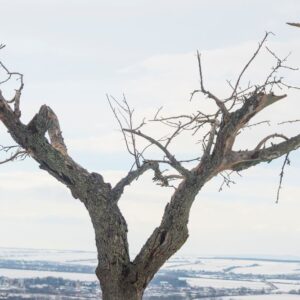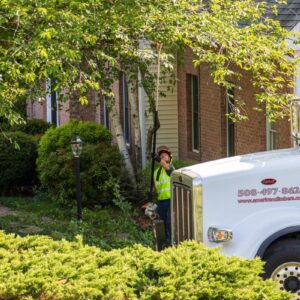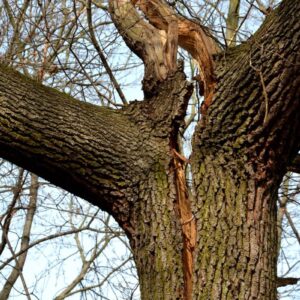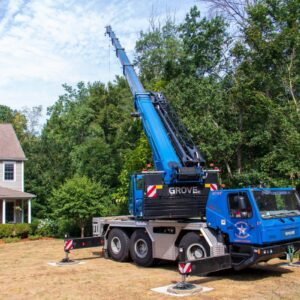Although there’s no such thing as completely preventing damage from the most powerful storms, there is a way to minimize Nor’easter and other storm damage caused to and by trees. By taking some preventive measures before the more common types of storms that we experience in Massachusetts, you can avoid the worst of the potential damage.
Unlike the last-minute notice we may receive that a Nor’easter is on its way, these are things that you can implement long before the wind and rain pick up and the sky gets dark.
How Trees Are Damaged by Storms
Most of us have seen what kind of chaos can ensue from a powerful storm. Downed power lines, branches through windows, uprooted trees, and worse. Strong winds are to blame for most of the damage, but rain can be an added stressor, causing flooding and loosening the soil, especially around tree roots.
The end result is trees being toppled by winds as the roots are pulled out of the ground.
This is even more applicable for recently planted trees that haven’t yet developed a large root system to stabilize them during unpredictable wind gusts.
Storms and Nor’easters also cause broken branches and even snapped tree trunks, making the trees dangerous to be around after the storm has passed.
Broken branches, in particular, can fall without warning, severely injuring a person or damaging a structure below.
And don’t forget the damage done to nearby buildings, wires/cables, and satellite dishes from branches that fly about.
REMOVING ALL TREES IS NOT THE ANSWER
You might be tempted to remove trees to minimize damage caused by high winds, rain, snow, and ice. But, as various storms have hit, we’ve seen that neighborhoods with the most tree cover actually have the least amount of damage and debris.
The secret is to have healthy, deeply rooted, well-maintained trees.
What You Can Do To Reduce The Risk of Storm Damage
The best way to minimize the risk of storm damage caused by trees, and protect yourself and your property, is to perform a regular tree inspection.
Take some time to examine your trees (from the ground – don’t try to climb them!). See if you spot any of the following issues, all of which increase the risk of damage from storms.
Potential Risk Factors
- Dead or damaged branches and/or trees. Look for deadwood, cracks or splits, hanging branches or any other sort of damage. These are more likely to snap when under pressure from high winds.
- Diseased or decayed wood. Trees and branches that aren’t healthy are generally weaker and more vulnerable to breakage.
- Structural problems. While a tree care professional is best able to identify structural problems that compromise the stability of a tree, there are some things you can see yourself. Look for V-shaped crotches, crossing branches that are rubbing against each other, and top-heavy trees (where the canopy has been excessively “lifted” to provide more clearance underneath).
- Severely leaning trees. Just because a tree is leaning doesn’t mean that it will fall over. But the more it leans, the greater the risk of failure, especially when rains have saturated the ground.
- Poor root structure. A tree that’s not firmly anchored is more susceptible to failure during a storm. Things to look out for include girdling roots, cut or damaged roots (such as from nearby construction) and newly planted trees with little root growth.
- Topped trees. We do not top trees because new growth is poorly attached and susceptible to breakage (among other problems). If a tree has previously been topped, it should be inspected for potential safety issues.
- Lion-tailed trees. This is another pruning method we don’t employ because of health and safety implications for the tree. During a storm, the heavy foliage growth at the end of long, bare branch gets whipped around, breaking the branches.
- Overly dense canopy. A tree with a thick canopy of leaves acts as a sail, rather than letting the wind pass through.
- Improperly pruned trees. Some trees are mistakenly “thinned” by removing a lot of branches from the interior of the tree, while leaving plenty of foliage around the outside. Unfortunately, this misguided technique makes storm damage more likely.
If you notice anything that concerns you, give us a call. Our tree care professionals are trained to look for potential hazards posed by your trees. We’ll be able to address these risks and take proper action – such as pruning or improving the health of your trees – before any major storms come through.
If you don’t have the time or the inclination to check for these issues with your trees, you can always contact us for a tree inspection.
Take Action Now To Prevent Storm Damage
Although Nor’easters typically occur between October and April/May, we also get strong summer storms in the Hopkinton and Metro-West area. That means that anytime is the right time to prepare for dangerous weather.
Properly pruning mature trees ensures that wind can blow through the tree’s canopy without causing damage. When a tree has not been maintained or pruned properly, the wind blows against the tree instead of through it, causing it to bend or snap. Along with the heavy rains, large branches are prone to break during storms and the whole tree can be toppled.
If you notice crossing branches, dead, damaged or diseased wood, or overhanging branches, we can also use corrective pruning methods to fix those issues and make your tree safer.
If you have a tree that has been transplanted or newly planted recently, properly staking it will give it extra support.
Some trees, however, may be beyond repair, in which case we recommend tree removal. If a tree is already dead, it’s best to remove it as quickly as possible, as it is almost guaranteed to fall during the next big storm.
We also provide storm clean up services for any downed or damaged trees or branches.
In Summary
Trees are part of our history and should be part of our future. They have the capability to withstand powerful winds and rains, but only if they’ve been given proper care.
Before Nor’easter season gets into full swing, consider the benefits of preventive pruning. Regular tree maintenance and pruning by a qualified tree service professional is the best way to keep your trees healthy and minimize the risk of storm damage. Investing in these services now can save you a lot of time, energy, and money in the future.
Blog Topics
Recent Posts
What's Happening? Stay Informed!
Stay on top of local events, pest and disease updates, tree and landscape tips, and more. Delivered straight to your inbox each month.










